Today’s poll sees significant movement since the most recent Irish Times/Ipsos poll in February, almost four months ago.
It contains good news for Fianna Fáil, but worrying signs for Taoiseach Leo Varadkar, who sees Fine Gael support slump. The poll comes after Varadkar and other Fine Gael Ministers have been trumpeting the cause of tax cuts in the budget, but there’s little sign of that cutting through with the public in a positive way.
With speculation about his leadership filling the Sunday papers last weekend, the poll is uncomfortably timed for Varadkar, and while it’s hard to see any real threat to his position the numbers today will increase the level of nervousness in Fine Gael and will fuel the continuing, low-level murmuring about Varadkar, probably throughout the summer.
Nor will the nervous nellies in Fine Gael be reassured by the lift in Fianna Fáil’s polling fortunes. The party sees a rise in its support today by three points to 21 per cent. In the 11 opinion polls published by the Irish Times since the last election, Fianna Fáil has been higher than this on only one occasion, after the lifting of lockdown in April 2022.
RM Block

Meanwhile, party leader Micheál Martin has successfully negotiated the transition from Taoiseach to Tánaiste, and though he sees his personal rating fall by four points today he is only a point behind Mary Lou McDonald and continues to run ahead of his government and his party. Indeed, Fianna Fáilers might tell themselves that their leader has come out of the December transition rather better than Varadkar has – which is no mean feat, and pretty much the opposite of what everyone expected.
This also underlines the question of the future of Micheál Martin’s leadership of the party. There are many who think that he will not lead his party into the next election; either way that is a question that will hang over the party for the next 12 months. It is a major uncertainty for Fianna Fáil.
The divergence in the fortunes of the two main parties of Government and their leaders also points to the inevitably complicated relationship they will have to navigate between now and the next election. After all, the two main partners in Government will be competing with each other for votes. That rivalry will have to managed. Recent wrangling over the budget suggests they have their work cut out on that front, while at a constituency level the forthcoming review of the boundaries will concentrate the minds of TDs about the challenges they face from their ostensible Government colleagues.
But at least Fine Gael and Fianna Fáil can find something to agree on in today’s numbers – their satisfaction at a slide in Sinn Féin’s support. While Sinn Féin comfortably leads its two main rivals – 10 points ahead of Fianna Fáil, 12 ahead of Fine Gael – this is the largest drop the party has seen in four years and the party has not seen a lower support level since February of 2021. In other words it’s the worst poll for a long time.

Sinn Féin remains, however, the undisputed poll leader and unbackable favourite to be the largest party in the next Dáil. Its case for leading the next government, however, is not strengthened today. On the basis of these numbers neither the present Government nor Sinn Féin plus smaller parties would have the seats to construct a governing majority in the Dáil. A protracted period of coalition-making is in prospect.
Interestingly, some of the Sinn Féin decline is among younger people and a chunk of it at least appears to have transferred to the Social Democrats, who see support jump by three points to 5 per cent. While the data in the poll does not provide reasons for this it seems likely that a combination of the appeal of new Social Democrats leader Holly Cairns and perhaps an unease with Sinn Féin’s climate policies among younger people are connected to it.
It is the first time that any significant challenge to Sinn Féin from the parties of the opposition has manifested itself in the lifetime of the Dáil. It has the feel of something that could be significant if Cairns can translate the attention she has got since she became leader into enduring support.
Both Labour and the Green Party remain rooted at 4 per cent each. Labour does not really seem to be going anywhere, and a sustained Social Democrat surge would pose obvious threats to the party. The Greens have shipped a lot of criticism lately, but the question that faces the party is not what the Healy-Raes and Mattie McGrath think of it; it’s whether it can persuade voters who are concerned about climate change to vote for climate action. The best way of doing this is to show tangible results in Government.
Solidarity-People Before Profit sees its support rise by a point to 2 per cent and Aontú, last month below the 1 per cent threshold, registers enough support today to make it on to the boards. Independent candidates are at 14 per cent, unchanged from last month. The importance of strong candidates – and not just party labels – in Irish elections cannot be underestimated.
Finally, there has been a sharp drop in the number of undecideds. They are not included in the party support figures cited above, which – in common with standard polling methodology –, distributes the percentage which says it doesn’t know who it would vote for proportionately among the various parties; you can’t actually vote “don’t know”. Anyway, the number drops by five points today, from 28 per cent in February to 23 per cent today.











